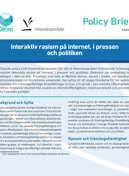There are plenty of historical examples of hate crimes of a systematic nature where the motive has mainly been to offend and harm people due to ethnic or religious group affiliation. With this research overview, Delmi wants to contribute to an overview of the current knowledge on hate crimes both internationally and in Sweden. The focus is on xenophobic and racist hate crimes (Afrophobic and anti-Roman hate crimes in particular) as well as anti-Semitic and Islamophobic hate crimes. The knowledge overview also discusses definitions of the concept of hate crime, the emergence of legislation and theories about the causes and behaviors of hate crimes.
Some overall conclusions and recommendations
- Many researchers claim that a hate crime is worse than the same crime without hate motives, because the purpose of the hate crime is to harm a whole group of people and the psychological damage can last for a long time.
- Hate crimes can lead to increasing conflicts in society and counteract the integration of minority groups.
- Many hate crimes are not reported, for example because the incident is considered trivial; the victim feels ashamed and does not want to appear in a lawsuit; distrust that a police report leads to something; or that one is afraid of retaliation from perpetrators.
- It is extremely important that hate crimes are met with strong distancing from leading politicians and authorities, and with clear measures. Politicians and police management must prioritize the task of creating trust among different groups.
- The police must have the ability and knowledge to investigate hate crimes, and the legal system needs better tools to deal with and assess hate crimes, and prosecutors and courts should be trained on a recurring basis.
About the authors
The knowledge overview, Hate crimes with xenophobic and racist motives (2017: 2), is written by Berit Wigerfelt and Anders S Wigerfelt.
Picture by Warren Wong from Unsplash.



